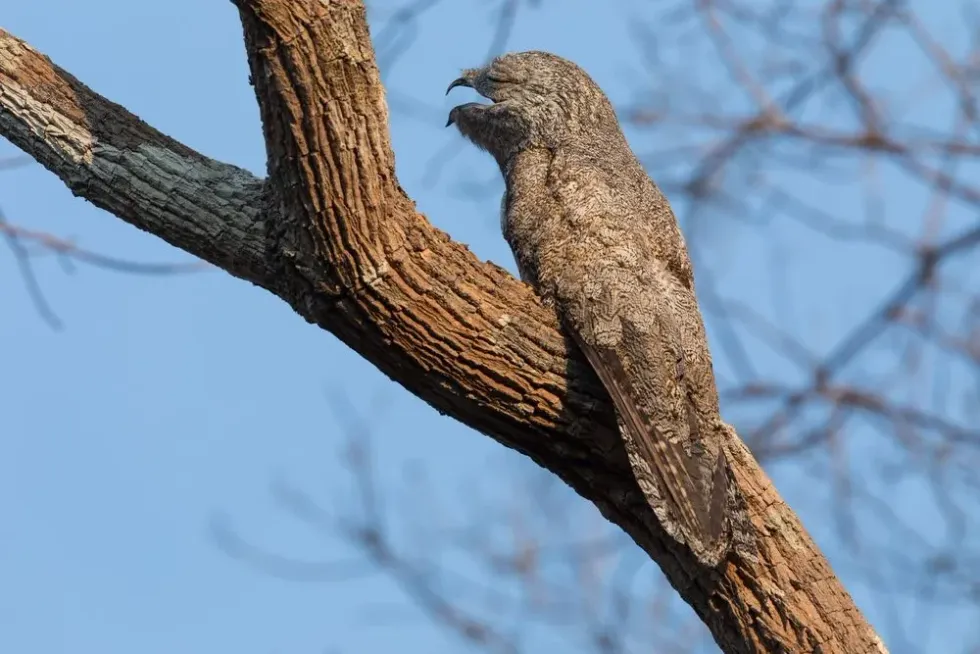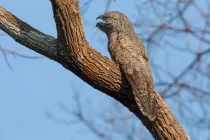Did you know some people do not believe that great potoos are real birds? Like an owl or any other bird, the big potoo (Nyctibius grandis) is a real animal.
Great potoos are primarily found in parts of South America and Central America. They can also be discovered in the Brazilian and Guatemalan jungles.
A great potoo is a much larger bird compared to a common potoo. They are nocturnal creatures that eat big insects, smaller birds, and bats, and they perch on big branches.
However, these carnivores often fall prey to animals like monkeys, collared forest falcons, and tayras. Monkeys attacking great potoos is quite common in Costa Rica.
Great potoos help maintain the natural balance in the ecosystem. Their breeding period occurs during the rainy season which may vary from one place to another.
They are solitary birds and it is uncommon to see great potoos flying in groups. One interesting fact about these birds who perch on branches is they have the ability to sense movement when their eyes are closed with the help of special notches on their upper eyelids.
Keep on reading to learn more fun and interesting facts about great potoos. If you want to learn about other species like great potoos, then check out our articles on red owls and mealy parrots.
Great Potoo Interesting Facts
What type of animal is a great potoo?
The great potoo (N. grandis) is a type of bird. These neotropical birds are the largest bird species of the order Caprimulgiformes.
What class of animal does a great potoo belong to?
A great potoo is a bird belonging to the class of Aves and the family of Nyctibiidae. Its phylum is Chordata and its subphylum is Vertebrata.
How many great potoos are there in the world?
According to the International Union for Conservation of Nature or IUCN, the number of mature great potoos present in this world is somewhere between 500,000-4,999,999. Their population is decreasing. However, the remaining number of birds is sufficient enough to not cause a threat to their population status.
Where does a great potoo live?
This species of neotropical bird has a wide geographic distribution. From southern Mexico in the north to Bolivia in the south, great potoo birds are seen across Central America. They can also be discovered in the Brazilian and Guatemalan jungles.
What is a great potoo's habitat?
A great potoo bird has a very interesting way of living and is quite widespread. Their natural habitat is the forests and rainforests of South America and Central America.
Forest edges, grasslands, foothills, and woodlands are also preferred places for this bird to live. It prefers a humid to semi-humid type of climate.
They perch or nest in branches of large trees that are 39.4 ft (12 m) above the ground during the day. The branches the bird chooses are generally 7.9-11.8 in (20-30 cm) in diameter.
However, this bird becomes way more active after sunset and prefers a perch or nest as low as 4.9 ft (1.5 m) above ground. The reason this bird needs trees is to camouflage itself from predators and to hide when it feels threatened.
Who do great potoos live with?
This species of potoo bird is known for being solitary and extremely shy. Its social side is noticed on very few occasions. These occasions include mating and another while a parent potoo bird takes care of newborns. Newborns are weak and incapable of protecting themselves, so the parent sticks around.
This does not remain the case when the chicks start to fly. During the day, this bird spends most of its time staying extremely still. The night is its time to shine and when it looks for potential prey.
How long does a great potoo live?
The exact lifespan of this species of potoo bird is not known.
How do they reproduce?
The breeding season of great potoo birds is generally during the rainy season which may vary from one region to another. This species follows a monogamous mating system which means one female potoo bird will mate with only one male potoo bird.
The incubation period of this species is not known. Females lay one egg a season in nests that they do not build.
Their nests are in the nooks of large tree branches. A parent of a young chick is always noticed around the nest but both parents are never seen together.
The chick grows up really fast and it fledges within 55 days from the egg being hatched and develops feathers within 14 days. The young one does not take much time to catch up to their parents.
It reaches two-thirds of an adult great potoo size in as quickly as five weeks and it does not take much time after reaching this point to fly. A great potoo chick starts to fly within 45 days.
The interaction with its parents starts decreasing from this point. Being solitary species, the young one leaves the nest within 60 days or once it is fully fledged and does not feel the need to return.
What is their conservation status?
The International Union for Conservation of Nature or IUCN Red List identifies the status of great potoos as Least Concern. However, their population is decreasing at an increasing rate. Like many other birds, they have been facing habitat loss due to deforestation.
Great potoos also fall prey to some animals like monkeys, collared forest falcons, and tayras. They also fall victim to hunters at times. Even though the number is decreasing, the remaining population is still quite large to be considered as threatened.
Great Potoo Fun Facts
What do great potoos look like?
Great potoo birds are blessed with distinguished features. They are large birds with large round heads and eyes.
The color of their eyes is brown but it can reflect as yellowish-orange at night. The beaks of great potoo birds are much shorter than their mouth and they have almost no facial bristles. They have a pale gray to brownish plumage which helps them to camouflage naturally.
How cute are they?
Great potoo birds can be categorized as many things but cute is not one of them. They are large birds with huge eyes that do not add to their cuteness. The call of great potoos is quite scary and can make your spine shiver.
How do they communicate?
Like most birds, great potoos communicate through vocalization. They are extremely inactive during the day so their calls are mostly heard at night. Two types of calls are quite commonly used by great potoos. One of the unique calls 'whoooap' sounds like a human moaning.
The second call is a deeper 'baaaao' and sounds like a frog. Sounds of these calls can be heard throughout the night but the 'whoooap' is more common. Calls of great potoos can be quite spine-chilling.
How big is a great potoo?
Referring to a great potoo as a big bird would be an understatement. Great potoos are the largest bird of the Nyctibiiformes order. No other bird in the potoos species matches their length.
Their size ranges from 18.9-23.6 in (48-60 cm) and they have a huge wingspan of about 27.6-31.7 in (70-80.4 cm). However, their height is not known. When compared to their relative common potoo, they are much larger in both size and wingspan.
How fast can a great potoo fly?
The exact flying speed of great potoos is not yet known.
How much does a great potoo weigh?
Great potoos are relatively heavy birds weighing somewhere between 12.7-22.9 oz (360-650 g). They have no sexual dimorphism so males and females of this species weigh the same.
What are their male and female names of the species?
Just like a common potoo bird or any other bird, great potoo birds have no distinguished name for a male or a female of this species. They are simply referred to as a male great potoo and a female great potoo.
Unlike many other species, this species of potoo bird does not have sexual dimorphism. It is very difficult to distinguish between the two genders.
What would you call a baby great potoo?
A baby great potoo is referred to as a 'chick' like other baby birds.
What do they eat?
Great potoos are carnivorous, nocturnal predators. They are found motionless in their nests during the day and they look for their prey at night.
After sunset, they come down to a lower nest as they prefer hunting from a lower level. Their body color and feathers play a major role in this process as they help them to camouflage naturally. In their camouflaged state, they wait for prey to fly by.
The diet of great potoos includes flying insects like grasshoppers, katydids, beetles, crickets, and moths. Great pottos are strong and intelligent predators that bats and other small birds also fall victim to them quite often.
Are they aggressive?
Great potoos are solitary and shy birds. It is not common for a great potoo bird to attack a human or cause any harm to them. However, they are capable of catching bats as well as large insects and small birds.
They are highly active during nighttime. A great potoo call can often scare people and give people shivers but these birds cannot be categorized as aggressive. However, being solitary birds they cannot be considered friendly either.
Would they make a good pet?
This species of potoo birds do not tend to make great pets. Their natural habitat is in forests and they are not known to do well outside of this.
Great potoo birds are nocturnal predators and their diet includes large insects, small birds, and bats. They are shy and prefer living alone which are not qualities of a good pet.
Although they are not aggressive, the call of a great potoo is quite scary and is not something you would want to hear in the middle of the night.
Did you know...
In Brazil, there are myths surrounding great potoos and the moon. As the spine-chilling great potoo bird sounds are heard at night, some people believe this brings sadness while others believe it is the sound of a spirit who loves the moon.
What is the difference between a great potoo's mouth and its beak?
A great potoo has a short but sharp beak. On the other hand, it has a huge mouth that can stretch wide enough to eat a bat. This wide mouth helps the bird be a successful nocturnal predator alongside its natural camouflage.
Do great potoos build nests?
Nesting is quite common in all birds. The nesting period of these potoo birds is generally from June to August or November depending on where they are located. However, they do not actually build their nests.
They perch or nest in large branches of 7.9-11.8 in (20-30 cm) in diameter and lay their eggs there. They very strategically select branches that are 39.4 ft (12 m) above the ground.
This height decreases the chance of the egg being stolen. During the night, they prefer nesting at 4.9 ft (1.5 m) above ground and hunting from there. This height helps them to hunt better and gives them the advantage of being naturally camouflaged.
Here at Kidadl, we have carefully created lots of interesting family-friendly animal facts for everyone to discover! Learn more about some other birds including the great grey owl, or barn owl.
You can even occupy yourself at home by drawing one on our owl coloring pages.










